
Left: You’ll notice that the gantry has been carefully tied to the side of the plane, because it doesn’t quite match the height of the cargo bay! Months later, the Electras faded into history, before making much of an impact. I took only a couple of flights on Electras before Western switched exclusively to jets.
Above: a collection of Western Airlines ticket folders and stubs document my yearly trips to and from Kodiak in the 1970’s. (The above is what happens when you clean out a box at Mom’s house!)
A quick glance at my travel agency card reveals that most flights in the northerly
direction necessitated an “all nighter” in the SEA-




Commercial jet service to ADQ: this vintage photo (circa 1972) shows a Western Airlines Boeing jet about to take off, with the famed Barometer Mountain in the background. Western was absorbed into Delta Airlines a few years later, after canceling the Seattle to Kodiak run that had been such a lifeline for island residents. Photo courtesy of Dirk Sundbaum
Transitions: PNA Becomes Western, NHB becomes ADQ
Western Airlines bought out Pacific Northern Airlines sometime around 1967, and the
transition to the Western Air Lines name and aircraft began shortly thereafter. The
photo above was taken in the spring of 1965 out the window of a Constellation as
our family flew north from SEA-

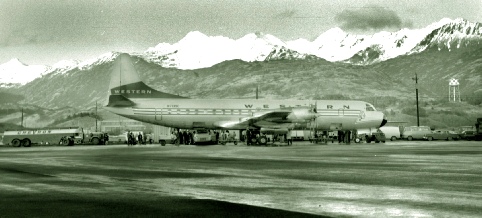

The above three tinted photos show the inaugural Western Airlines Electra flight. It lands, unloads, and prepares to take off (with a Coast Guard plane beyond, waiting its turn) in this sequence from 1969. But within months, the Electras were replaced by Boeing jets.

Runways to Remember, Part Two (ADQ and KDK)
By Timothy Smith, Originally posted in 2011, latest revision in 2020
Runways To Remember Part 2
Part of the “How to Get to Kodiak” series of articles
(ADQ and KDK in Kodiak Aviation History)
Link to Part One
Right: The inaugural run of the Electra was a gala affair, with a lot of fanfare. The flight crew, moments after the official photo was taken, stand in front of the new Kodiak terminal, while various dignitaries (in the black coats) and airline workers (in the hats) prepare for a small onboard reception.
The Story of A PNA/Western Airlines Pilot (Added in 2020)
Gil Justiss wrote to me beginning in January of 2020 and passed on these photos of his father, Captain Jesse Justiss, and his planes. Captain Justiss flew in and out of Kodiak many times. The photos are from a trip in which Gil’s mother accompanied his father on several flights, including Kodiak. Here is Gil’s account, along with a description of his photographs.
About the above photo:
From Gil Justiss, 1/2020: “My father was a pilot for PNA, then Western. After WAL retired PNA’s Connies, my dad moved onto WAL’s 720 / 707’s. I have attached a picture of my father Capt. Jesse Justiss in his WAL uniform. The picture appears to be taken with dad standing at the top of the air stairs as he is boarding a 720 or 707 (determined by the fanjet engine in the left of the photo). The location written on the back is Kodiak. but I am suspect as the writing is my mother’s. Can you confirm by the terminal building and mountain terrain that it is indeed Kodiak?”
(I informed Gil that the photo is indeed Kodiak ADQ airport, with Pyramid Mountain towering behind, taken sometime in the early 1970’s.)
About the above two photos:
From Gil Justiss, March 2020: “I have attached two more photos, of my dad / flight
crew and a ground crew member on air stairs exiting a 707PC that may have been taken
at Kodiak also. Western operated 707 combi’s -
My comments: The jets in and out of Kodiak did use the freight packs designed to slide on a track inside the Boeings like Western Air Lines was using. But I’m not sure which Boeing models were used in that way. Passengers would sit in a smaller cabin behind the freight, with a moveable bulkhead between them and the packs. That put most of the heaviest weight over the wings, for stability. Several flights that I took to Kodiak had that setup. In the photo on the right above, a white freight pack with visible straps is just to the right of Captain Justiss’ head. The man in the hard hat is on the lift that was used to slide the packs into the cabin. See my brother’s comments further down for more on this.
About the photo to the Right:
Gil Justiss writes, “I attached another photo of dad taken on his last trip – LAX – SEA – LAX Jan 1980. I took the photo upon shutdown at the gate in SEA. I rode the jump seat all the way on the trip north. The aircraft went back to LAX the next day and was retired itself. WAL was retiring out all 720 / 707’s and had hung onto them longer than anticipated due to delayed / slow delivery of then new DC10’s.”
My comments: I love photos like this for two reasons – first, it humanizes all the planes we’ve seen to view the pilot in his element. Second, since I, too have recently retired, I can really appreciate Captain Justiss’ big smile!
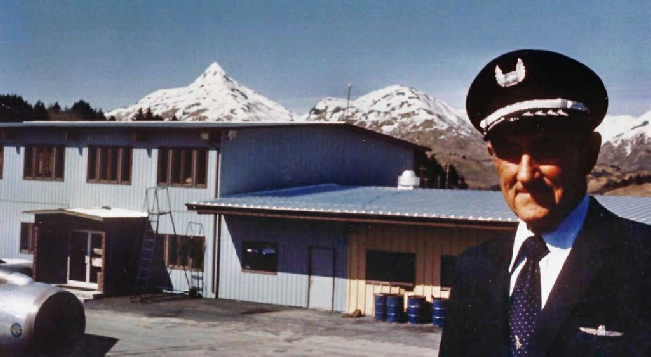

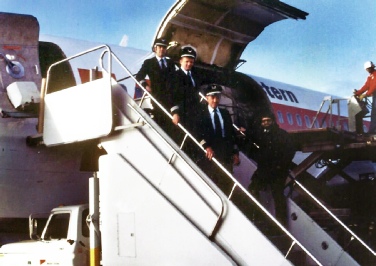


Stubs document that the Alaska-
Many of the State of Alaska’s destinations are so remote and conditions so hazardous,
especially in the off-
ADQ Today (Recent Photos of Kodiak’s Airport):

No, I didn’t take this photo! This beautiful photo was taken by Drew North in 2006 from the summit of Barometer Mountain.
It shows the runway, the base housing near Lake Louise, and the town beyond, bathed in sunlight, with Pillar Mountain covered mostly by shadow. Woody and Long islands are on the horizon. The photo was taken after Drew had climbed Barometer Mountain; more power to him! It’s a journey I’d have to take by helicopter! Hats off to the hardy souls who can clamber up that peak and experience such a sight firsthand. The photo also tells you almost everything you need to know about the dangers of the main runway at ADQ!
Steve Harvey’s Widgeon taxis on the runway in this October 1996 photo, taken from beneath the wing of another aircraft. For some spectacular photos from Steve’s collection, please see the new article, “Goose and Widgeon – Still Flying!”

Traffic jam? A big Alaska Airlines Boeing jet taxis on the cross runway below us as we bank away from the airport in a small commuter plane in this 2003 photo.
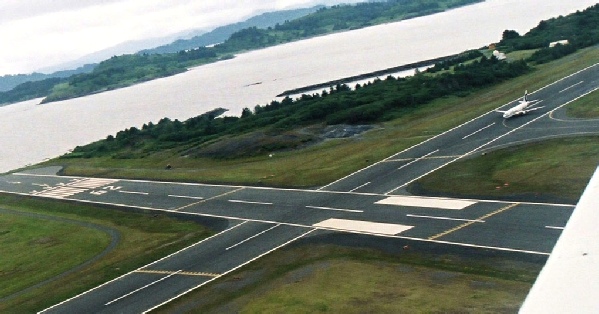
In 1997, when my brother Kelly and I flew down to Larsen Bay, the plane actually took off toward the mountain! This is apparently no big deal in certain wind conditions, but it was none too comfortable for me. The photo captures the foliage on Barometer just as we banked, and Kelly turned to check on my reaction.


KDK: Kodiak’s Other Airport
(The Landing Strip in the Middle of Town)
I once considered the city airstrip to be a long way out of town. It’s now between McDonald’s and the Safeway! There have been rumblings of closing it down, but it’s a valuable asset, and it would be a shame to lose it. Not all the small plane traffic in town is water based, and the big airport is not set up for much private traffic. However, when I last visited Kodiak, all commercial enterprises that flew wheel planes were headquartered out at the main airport at the base, near the Alaska Airlines / ERA terminal.
Now that the seaplane port is operating, there’s been pressure to kill float plane traffic in Lily Lake, too. But again, that would be a shame, and Kodiak would lose some of its trademark charm if the community was completely isolated from its aviators! On the other hand, I don’t consider a prop plane taking off to be noise, so I suppose I’m in the minority on that one.
The historic photos of KDK airstrip come from Dirk Sundbaum, who worked for Kodiak Western Alaska Airways (KWAA, formed when Kodiak Airways merged with a carrier that serviced the mainland). Thanks to his excellent slides, we have a vivid look back on the comings and goings of KDK when it was a major transportation hub for access to “the bush”, and also a backstage pass to the inner workings of the KWAA hangar, where skilled mechanics worked to keep their fleet, including the aging Grumman amphibians, airworthy and spiffed up. It was amazing what the crew could do with their machine shop and paint sprayers!
Classic photos from the collection of Dirk Sundbaum: the next eight shots from the early 1970’s record some of the aviation history of the little municipal airstrip in Kodiak, KDK.
This winter sunset shot shows Lily Lake covered with ice and snow machine tracks, with the airstrip beyond. Notice that none of the houses had yet been built on the north (left) side of the lake.



These photos from the early 1970’s show the interior of the Kodiak Western hangar (on the far side of the airstrip) with a Widgeon (left) and Goose in various stages of repair. Given the age of the planes, the mechanics had to do most repairs themselves, often crafting their own replacement parts.
N85U is an example of a Widgeon that was built out of the pieces of several other planes. You have to do such things when you are dealing with an airframe that predates World War II! Here it is nearing completion in the Kodiak Western hangar at KDK.

The mechanics did a beautiful job on her. Fred Ball thinks this pretty paint scheme was designed by Dirk Sundbaum. Please see “From Shore to Sky” for a detailed look at what happened to N85U next.
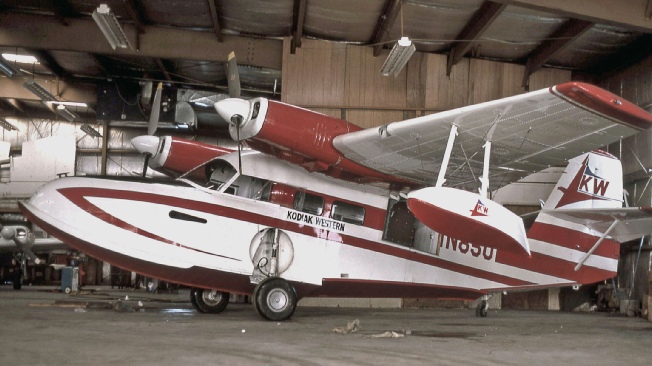
The legendary N87U Goose comes in for a landing, seeming to hover in the air. This plane (in Kodiak Airways colors!) is depicted in a photo display at the Smithsonian, in the same building that houses the moon rocks and Lindbergh’s plane. See the article, “Goose Stories” and see volume one of “Runways to Remember” for more on N87U. This venerable plane now has original Navy colors, and occasionally appears in movies and air shows. But in this photo, it’s just another day in Kodiak, and another routine landing at the Kodiak Airways terminal at KDK.

A Kodiak Western Beechcraft 18 Volpar comes in for a landing at the airstrip. The
“Volpar” designation refers to its nose wheel configuration, since it also was produced
with tail wheel models. According to one of the Goose pilots, this craft was flown
most often by less-

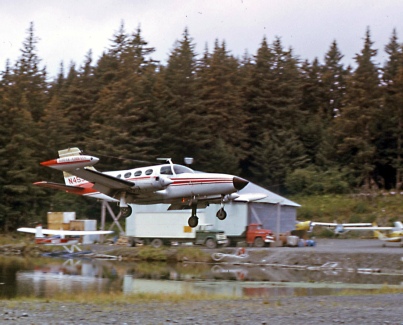
Dirk’s photo of a KWAA Cessna 421 landing shot shows the end of the runway and the shore of Lily Lake, with both float and wheel planes in evidence. Just outside of frame to the right is the KWAA hangar, where all the aircraft rebuilding was done.
Two Goose Accidents (Dirk Sundbaum photos)
The pilots and mechanics of KWAA were surely among the best and most innovative problem solvers in the business. This section documents a couple of amazing emergency repair operations that happened while Dirk Sundbaum worked for the airline. The first two photos show a daring return flight for a Goose that lost one of its pontoons when it hit an object while in the water at Akhiok, a village on Kodiak Island’s South End.
On a routine flight to Akhiok…
...the left pontoon was nearly sheared off when it hit a log as the plane was taking off.
So how was it fixed?
First, it isn’t unusual to encounter partially submerged logs in the waters around Kodiak, and they can do substantial damage to boats and skiffs, as well. Being almost invisible and very heavy from being literally waterlogged, hitting one is almost as bad as hitting a rock!
Second, a Kodiak Airways mechanic had to be prepared to fix just about anything, and anywhere!
So, Kodiak Airways mechanic and pilot removed the damaged pontoon, stashed it in the cabin, waited for very calm water conditions, and carefully flew the plane back to Kodiak. They took off with all the weight they could find lashed down on the right side of the plane’s cabin, and making sure to angle the Goose so that it would not need the missing pontoon!
The second photo sequence features an even more hair-
Once they thought N88U was airworthy, Dale Moore flew it out using wheels only, making sure the lake was sufficiently frozen, which explains why they didn’t replace the pontoons (which usually strip off in accidents such as this). “Airworthy” in this case means good enough for these guys to coax it back to town, but most of the systems on board were still offline, and only the engines and controls were fully functional. The Goose was flown back to town, but with another crew in a “chase” Goose following, providing radio contact with Kodiak and watching carefully in case there was trouble on the way home. Observe the two photos below:


The accompanying “chase” Goose is visible in the photo, observing the landing from above the airstrip. If the damaged plane had experienced any difficulty on the way back, it would have had to attempt a beach landing, since the wheels were locked in the down position! When I was examining this photo, the landing Goose looked more and more “wrong,” and it was unusual to see a second plane so close behind. I sent the photo to one of the pilots, who filled me in on the amazing story behind these photos.
This angle shows not only no pontoons, but substantial damage to the bow (sorry, “nose”) of the Goose. Also visible are the bent wing tips from the impact of the hard landing. This plane was later sold, completely rebuilt, and flew again. According to Internet sources, N88U is now owned by a pilot in Indiana, who added all sorts of modern avionics gear and special modifications to it, making it one of the best equipped Gooses flying today.
Some photos of KDK from my visits to Kodiak
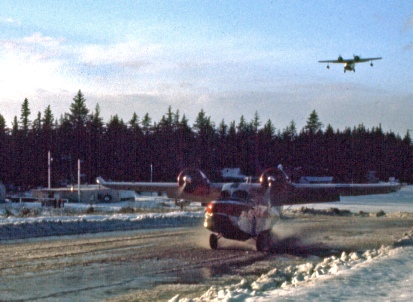

An Island Air flight prepares to depart for Ouzinkie in 2003. The pilot is holding his aluminum clipboard, and the tie down cable is clearly visible beneath the plane.
The white strips at the lake end of the runway are barely visible in the sunrise, 2004. King’s Diner is only steps away to the right of this photo.


Above: The famous King’s Diner is a few feet from the strip; I stood near the extreme west end of the runway to get this photo. Below: The interior of the diner shows a loyal clientele on a Saturday morning in May, 2010. Eleanor King runs an excellent place! Always order the sourdough pancakes and something with reindeer sausage and eggs, from a place that should be a lot more famous than it is.
My wife Debbie and I are ready to pig out at King’s Diner. I ordered sourdough pancakes and a reindeer sausage omelet. Debbie has an order of blueberry pancakes. The truck stop ambience of the place is augmented with cool aviation art and a clear view of the airstrip 100 feet away. This is where the locals hang out. Food Network, are you paying attention? 2007 photo

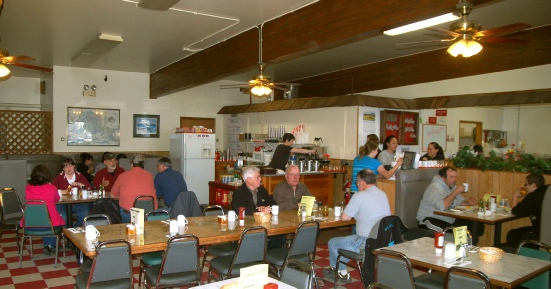


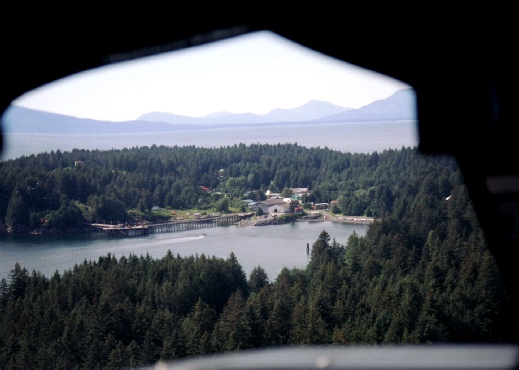
My destination, my hometown of Ouzinkie, appears through the plexiglass of an Island Air plane as a skiff pulls into the bay below. Our trajectory is taking us to the KOZ landing strip. 1998 photo. Note: I have not yet seen Ouzinkie’s new runway or its new ferry dock. Likewise, many things have changed in Kodiak, too, since I first posted these articles. That makes them a time capsule, and hopefully interesting to folks out there.
A view over the pilot’s shoulder down the runway toward Lily Lake in this 2004 photo
Conclusion: Unique (Daily) Adventures
This affectionate photo essay will hopefully bring back a lot of memories for old-
As someone who lived for 40 years within blocks of two major freeways, surrounded by traffic lights, I can tell you it’s wonderful to watch Kodiak people getting around! My Idaho home now has Home Depot, my Toyota dealer, my bank, and two supermarkets just a mile away to the west. But I’m only three blocks from the start of a Canfield Mountain trail, and six miles in each direction from huge lakes rimmed with Douglas Fir and Ponderosa Pine. And we bought this place because it reminded us a little of Kodiak.
So on those rare occasions when one of those departing flights includes me, don’t be surprised if my camera is constantly in use, as I attempt to capture however imperfectly the essence of one of Kodiak’s everyday adventures. The companion piece to this article can be found at this link: “From Shore to Sky: Kodiak’s Planes that Float”

Welcome to Kodiak! We end this photo essay where we started, at Kodiak’s unusual
main runway and the ever-
Link to “Runways to Remember Part One”
Acknowledgements:
I wish to thank Dirk Sundbaum, a Kodiak Western Alaska Airlines (Kodiak Airways) employee in the early 1970’s, for the photos which contributed so much to this essay.
I also wish to credit Fred Ball, master Grumman amphibian pilot, who helped me identify aircraft, correct mistakes, and clarify wording throughout. His photos (and my photos of him in action) are featured in the article “Goose and Widgeon – Still Flying” at Tanignak.com.
Finally, I wish to thank Gil Justiss for finding me on the web and contributing those great photos and stories of his dad, Captain Jesse Justiss, and his Western Air Lines / Kodiak connection.
Timothy Smith, web author, 7/2011 and 3/2020.
For more on Kodiak aviation, including much more information on the Goose and Widgeon, and many more historic photos, please follow the links in the photos below.




To Find Out More About Tanignak.com, Click HERE
To Visit My “About Me” Page, Click HERE
To Return to Tanignak “Home,” Click the Logo Below:

Information from this site can be used for non-

Also Arriving at ADQ: Wien Air Alaska!


The time exposure above is a photo I took at SEA-
Our flight in and out of Kodiak in 1969 was via Western jets like the 720B seen above. At the far left, beyond the Pan Am jet, is a Boeing jet which still sports the Alaska flag and “PNA” designation on the tail.
My Brother Kelly (Former Alaska Airlines Lading Officer) Comments on Air Freight Methods in Alaska (Including Kodiak) in the 1980’s and 90’s
I texted my brother about the combi’s mentioned above, and he wasn’t sure how many Western Air Lines planes, or which models, were used for freight or freight and passenger combinations. But he is very knowledgeable about Alaska Airlines, Mark Air, and Wien Air Alaska, including aviation in and out of Kodiak ADQ. So here are some of his comments.
I don't have any photos to share but rather a few comments to add to your existing
info. If WAL used the same system for "combi" aircraft that Alaska Airlines did (which
isn't all that likely) then the passenger seats would have been on "pallets" of the
same general dimensions as the freight containers. As at Alaska and Mark Air, the
evidence for that would have been a slightly unstable feel to the floor, and a slightly
elevated seat height in relation to the window, all due to the "roller" sub-
The Igloos themselves, at least when Alaska was using the combi's, had one side cut
back to allow a person to walk past. This was mandatory in my time so flight crews
could move between the passenger compartment and the cockpit, for safety. At Alaska
Airlines, there was even a purpose-
It happened a few times! At least a couple times a horse destroyed the enclosure, and hurt themselves in the process. And there’s nowhere for the poor handler/vet to get away from it!
Weight and balance was often tricky when passenger loads and cargo weights were greatly different. This combi system was and still is an excellent way to accommodate such things as “bypass mail,” a low cost option that a vendor could use to ship out to the “bush.” The one thing that stands out in today’s aviation world is that “combi” flying meant not doing either freight or passenger service at 100% efficiency; the creature comforts for passengers, and freight carrying capacity both being limited.
Below: a departure toward the mountain, with a hard bank to the right as soon as airborne.
Evidence that Kodiak aviation will always be a bit of an adventure: on May 2, 2010,
I took off from ADQ on an ERA Aviation flight, and the brisk wind direction out of
the north again dictated a departure toward the mountain. The pilot had us all sit
in the back half of the plane! I shot this photo as we passed the end of the runway
and the terminal. We’d already gained some altitude before we banked away from Barometer,
but my extra-